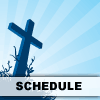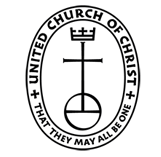Sustenance – Sermon on June 6, 2010
June 6, 2010
Scripture: Luke 9: 10-17
On their return the apostles told Jesus all they had done. He took them with him and withdrew privately to a city called Bethsaida. When the crowds found out about it, they followed him; and he welcomed them, and spoke to them about the kingdom of God, and healed those who needed to be cured. The day was drawing to a close, and the twelve came to him and said, “Send the crowd away, so that they may go into the surrounding villages and countryside, to lodge and get provisions; for we are here in a deserted place.” But he said to them, “You give them something to eat.” They said, “We have no more than five loaves and two fish—unless we are to go and buy food for all these people.” For there were about five thousand men. And he said to his disciples, “Make them sit down in groups of about fifty each.” They did so and made them all sit down. And taking the five loaves and the two fish, he looked up to heaven, and blessed and broke them, and gave them to the disciples to set before the crowd. And all ate and were filled. What was left over was gathered up, twelve baskets of broken pieces.
Sermon: Sustenance
By Reverend Doreen Oughton
Today, some Christian denominations celebrate a special feast or festival. It is not a tradition in the United Church of Christ, nor in the denominations that formed the UCC – Congregational Christian and Evangelical & Reformed. But I felt called to explore this special feast, and build a worship service around it. Today is the Feast of Corpus Christi, the celebration of the body of Christ. It was added to the Christian calendar as a feast day in 1248, when a Belgian nun, Juliana finally told about the recurring vision of Christ she’d had for the previous twenty years, in which she was instructed to plead for the institution of such a feast. She was inspired to plead her cause at a time when “the faith of the world was growing cold, and heresies were rife,” as a way of encouraging the faithful to draw new strength and vigor from this source of life, and so that the irreverence and sacrilegious behavior around the sacrament could be repaired. It was expanded to celebrate not just the corpus, the body, but also the blood of Christ, both of the elements that we use in the sacrament of Communion.
We celebrate Communion at the request of Jesus. He was the one that instituted this ritual, and he is the one who referred to the simple elements of their supper, the bread and the wine, as his body and his blood. We bear witness over and over again in our Communion liturgy, recalling his actions of taking, blessing, breaking and sharing; recalling the words he spoke with his disciples at his last meal with them before his death, “this is my body, given for you, this is the blood of the covenant, poured out for you. Do these things, remember me in doing them.” His earliest followers did as he requested, and the practice spread throughout the household gatherings of the early church. Paul wrote quite a bit about the practice, advising and correcting the communities who developed customs that caused problems. He admonishes the Corinthians, where he has heard that when they have gathered, supposedly to eat the Lord’s supper, they eat instead their own supper, and some go hungry while others get drunk!
That’s not what this should be about, Paul tells them. Instead of resulting in such disparity, Communion should bind us in greater unity. There is one bread, and all the many who partake of the one loaf become one body. I find the layers of meaning in the term “Body of Christ” to be absolutely poetic. That bread there (on the table) is the body of Christ. We each, individually, take it into our bodies to strengthen our union with Christ as individuals, and we take it together, from the one loaf, to strengthen this church as a Body of Christ, and we take it as other churches take it to strengthen the Christian church universal as the Body of Christ.
And I love that the scripture recommended for today is not of the Last Supper, but of the first large-scale feeding by Jesus. This story contains similar layers. The feeding is done by Jesus who again takes, blesses, breaks and shares; and by individuals who contribute their bread and fish; and by the whole assembly with their additional baskets – twelve remaining of broken pieces. And this story happens well before that Passover meal where the Communion ritual was established. This story tells us that Jesus has always been interested in feeding the people who follow him, and has always wanted us to feed each other with his help.
I’ve heard this miracle story explained as a miracle of changing people’s mindsets from scarcity to abundance. Once those bread and fish were contributed, and the baskets with a little bit of food in them were starting to be passed, people were moved and inspired to take what they had been hoarding for themselves and add it to the baskets to share with others instead. Could be, could be. Jesus tuned into the needs of the crowd and suggested that his disciples take some responsibility for addressing the need, even though it looked like an impossible task. Jesus took a step in faith, and his belief that all could and would be fed was contagious. And so many people responded with a sense of care and responsibility. It must have been a truly communal moment, taking a little for yourself, adding more for others, until everyone had their fill and there were twelve baskets leftover.
But I get jazzed with the idea of a more miraculous multiplication of the food, a bigger action on the part of Jesus. Maybe it was both – the original loaves and fishes were multiplied enough to give the groups of fifty more than a little nibble, and then others added to it. A generous giving, and a generous receiving.
There are different ways of understanding Christ’s presence and participation in our Communion rituals and elements today. Some believe that the bread is quite truly transformed, or transubstantiated, into the actual body of Christ, that what is ingested is the literal, physical flesh and blood of Christ, even though it still looks like bread and wine. We take in his whole self and life in a concrete way. Others believe that the flesh and blood are infused into the bread and wine, so the substances co-exist. What is taken in is Jesus’ body and blood, along with the everyday elements of bread and wine, and each remains unchanged. And others hear Jesus’ words, “this is my body, this is my blood,” as metaphor – this is like my body, broken, this is like my blood, poured out. When we eat and drink, we are symbolically taking him in, by remembering his teachings, by remembering his ministry and his call to his followers to continue in his ministry.
In the first two, it is the action of the Holy Spirit, the initiation of Christ, that is by far the most important. We need only take from the basket that’s passed, so to speak. In the last understanding, our response to what Jesus started is the thing that increases his presence. We take a little, and add more, we add our active remembering, our active self-examination, our active renewal of commitment to following him. But of course even with the beliefs of transubstantiation and consubstantiation, a faithful response is called for. If we have ingested Christ’s very self, of course our commitment to following him is refreshed anew. Of course we would be moved to hear his words to the disciples, “You feed them,” and pony up our loaves and fishes. Of course we would know that in sharing from the one loaf, we take action that acknowledges that we the many are truly one body.
However we understand Jesus to be present at the Communion table, we can trust his words in the gospel of John: “It is my Father who gives you the true bread from heaven. For the bread of God is he who comes down from heaven and gives life to the world. I am the bread of life. Those who come to me will never go hungry, and who believe in me will never be thirsty. So come, believe, eat and drink at the eternal banquet of our loving God.” May it be so.








